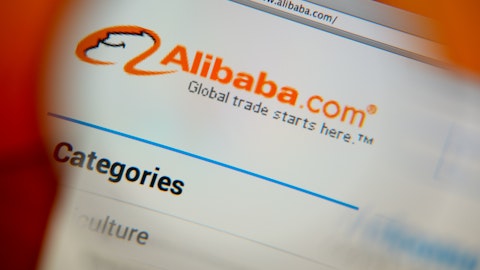And the sum total of that for last year is we think the team produced about $1.5 billion of incremental GMS. We’ve tasked the team with more, even more efficiency than that this year. We continue to find ways to get more efficient, leveraging new tools and techniques, leveraging new processes. We’re pretty agile and we work on getting even more agile and even more focused. And then with performance marketing and above-the-line marketing, we’re also always working to get more efficient. And I’m realizing now is when I talked about how the algorithms are doing the work, I don’t want you to think it’s static. We also have multiple squads working on MarTech. And they’re constantly focused on things like, how can we make our landing pages more efficient?
How can we perform better in SEO? How can we make our bids, you know, even more sophisticated, segment our audience even more? So we’re constantly driving efficiency gains from each of our teams and each of our dollar spend. And so what we’ve done is we’ve looked at our plan for the year, what we think it’s going to deliver in terms of incremental GMS. The assumption on that, again, is what’s going to happen with the baseline, and that is the part that’s hard for us to know. So the risk in this plan is, you know, I think we’re going to execute on the plan and I think we’re going to drive a lot of value. And what’s going to happen with the baseline and to what extent is that a tailwind or a headwind to us for the year is still yet to be known.
Rachel Glaser: On the $90 million, a couple of things that I want to point out. We reduced our workforce by about 12%, and we cut various operating expenses where we thought that there was room to cut them without losing any productivity or efficiency in operating our business. Of the workforce reduction that we made, we also reduced future open hires. So the — we not only saved current dollars, but we’re saving some future dollars. We — our main focus is always on the Vital Few. So what we — the guiding principle of what we are about was to reprioritize and realign our teams to be working on the fewest possible things that are driving the highest possible impact. That does not mean that we’ve stopped hiring and that we’ve stopped investing.
We see so much room for growth. We talked about our $500 billion TAM, we’re in less than 2% of it today. We just have so many ideas. Josh laid out a bunch of them that we’re currently working on, on the call. So we’re continuing to invest for growth. We are at the top of the pack in terms of revenue per headcount in the company. We’re very lean. Etsy alone, just Etsy, is only about 1,800 people. And the revenue per head, it’s hard to find companies of our size and shape that have revenue per head, you know, higher than that. We’re really winning there. And if we cut too far back, we’re going to, you know, get in the way of our own ability to invest for growth. So we feel very comfortable with finding — constantly looking for, you know, operational efficiencies, very comfortable with the way that we’ve reprioritized our expense buckets and very comfortable with the level of investment we’re making going forward.
Josh Silverman: And I just would add that I find the whole commentary on the year of efficiency interesting because every year is a year of efficiency for us, every quarter is a quarter of efficiency. There hasn’t been a quarter or a year when we’ve said, screw it, let’s just, you know, invest and hope for the best. We’ve been obsessed with efficiency and value creation per dollar invested for the seven-plus years that Rachel and I have been here. And so every quarter we are looking at, is there a way to squeeze more efficiency? Is there a way to cut more cost? And when we find an opportunity to cut costs, the first thing we look at is can we invest that — reinvest that profitably to drive growth. What’s going to really move the stock price is getting growth, getting GMS growth up again so that we’re driving the multiple.
That’s what’s going to drive growth, but we have to do with cost discipline. So what we’re not going to do is invest irrationally, invest a dollar to get a dollar or less back. So when we see an opportunity to put that money back into something that’s going to drive growth, we’re going to do it. The result of that is a business where at the core marketplace on Etsy generates EBITDA margin right now over 30%. It’s hard to find a marketplace of our size and scale generating EBITDA margins anywhere close to that. And we’re very focused on also reinvesting for driving growth. And we’re going to continue to make sure we balance those two with an emphasis on investing in growth when we think there’s a good opportunity to do so.
Deb Wasser: Thanks, Shweta. Because you got two in there, we’re going to go to the next question.
Shweta Khajuria: Thanks.
Josh Silverman: Thanks, Shweta.
Operator: Our next question comes from Steven Forbes with Guggenheim Partners. Please unmute your audio and your video and ask your question.
Steven Forbes: Good evening, everybody.
Josh Silverman: Hi, good evening.
Steven Forbes: I mean, maybe just to expand on some of the initiatives, you know, like Gift Mode and loyalty, you mentioned the investment in the Big Game advertising. You know, anytime you sort of hear loyalty, you know, it helps if you can maybe contextualize what you’re thinking of doing with loyalty as we, you know, potentially have like timing disconnects with the benefits and, you know, maybe some market implications. So, you know, just any sort of expansion on what you mean by loyalty.
Josh Silverman: Sure. I would say we don’t have anything to announce yet. And I know that’s not going to be very satisfying, but we pay a lot of attention to loyalty economics in a lot of places, having cited Amex, where not only does Amex run really big loyalty programs and things like membership rewards, but we partnered with when I was at Amex Delta and Starwood and a lot of other places. Had a chance to study a lot of loyalty programs. And thinking hard about, which are the ones that truly drive more return and truly drive more consideration, is a big focus for us. It’s got to have both rational and emotional benefits. It can’t be just rational. There’s got to be some yearn to it. And the goal is to get people to consider Etsy more often.
People love Etsy. Talk to buyers and they’re all going to say, I love Etsy. Why didn’t you shop in Etsy more often? I didn’t think of it. So committing to some form of loyalty program, we think can get them to prioritize Etsy and say I’m in this loyalty program, I should stop by Etsy and see if they have something to offer. If we can just get them to stop by, and see if we have something to offer, the answer is going to be yes, a whole lot of the time.
Steven Forbes: And then maybe just a quick follow-up, right. A lot of noise out there in terms of AOVs or ticket-related challenges, across the discretionary landscape, or just where deflation is, right, within the respective categories. You mentioned sort of this optimism around stabilization in GMS per active buyer. Curious if you could maybe expand on what’s giving you the optimism, and what you’re seeing with price behavior across the product categories you serve.
Josh Silverman: It has stabilized a bit. If you look at the last four quarters, GMS per active buyer have been relatively stable at $126. So that’s good news. And by the way, that’s up from about $100 before the pandemic. So in spite of all the headwinds, and everything we’ve talked about with the macro, still spending 20% more, more than 20% more than they were pre-pandemic. In the headwinds for the beginning of this quarter, when we said we were off to a slower start, AOVs are down slightly. So when we talk about starting from a low – down mid-single digit and guiding to – we think we will get back to low single digit, by the end of the quarter. One of the headwinds we’re seeing is AOVs are down. The good news on that is, it means transaction volumes are actually holding up better than, what those numbers would suggest.
Buyers are still coming and buying on Etsy. They’re just even more price sensitive in this moment. And that, I think, is pretty consistent with what we hear with a lot of others.
Steven Forbes: Thank you.
Operator: Our next question comes from Anna Andreeva with Needham & Company.
Anna Andreeva: Great. Thanks so much. Thanks for the color guys. We had one question on take rate. Came in a little bit better than expectations in the fourth quarter. What’s driving that expectation for the year to be at or higher than Q4 levels? I think you mentioned some of the seller onboarding fees. And then secondly, the number of churn buyers, I think, increased a little bit in 4Q. Can you further elaborate on that? Thanks so much.
Rachel Glaser: I’ll take the first, you take the second. Okay. So the – we rolled out Etsy Payments to nine more markets. So that helps us a lot with incremental transaction fees that we just weren’t getting before. And today, we launched the seller fee, which not only has the benefit of incremental take rate, which, by the way, completely is reinvested back in safety of the marketplace. But it creates – did you call it friendly friction earlier? Friendly friction so that we create a little speed bump, for not just any seller can create a listing for $0.20 and some kind of product. It’s a moment to think about, well, I’m going to have to make payments fee. And that helps us with bad actors on the site, so that we get both the benefits of that.
Josh Silverman: Yes. And that, by the way, is not a big take rate driver. I think the revenue in that is going to be relatively small, but it’s going to be good value exchange, making sure it’s really secure to become a seller on Etsy. And I think that’s good for all of the sellers and the buyers on Etsy, and the fee we’re charging is nominal. If it’s not worth $15 to create a shop on Etsy, then maybe you’re not committed enough to likely succeed on Etsy. But that’s not a huge revenue driver. We’ll continue to see payments coverage expand in other markets and other areas where we think there’s fair value exchange, and we think we’ll achieve the take rate that we guide into.
Rachel Glaser: Let me add a quick one to that. Just also when we see international business increase, we get a slightly higher take rate on Etsy Payments where the buyer and the seller are two different currencies, because we have a premium that we charge for that currency exchange. So that’s another thing affecting take rate. And lastly, we did see nice lift from Etsy ads again, and we’ll continue to see Etsy ads improvement, as we continue to make investments in the better – and better the search broad relevancy is for Etsy ads higher the conversion rate.
Josh Silverman: And on active buyers, we ended the quarter – ended the year with about 92 million active buyers on a trailing 12-month basis. So at an all-time high. Roughly stable. I don’t want to crow too much about it, roughly stable from the prior quarter. But I’m not sure where the comment about more churn was, but I’d say active buyers have been stable.
Anna Andreeva: Okay. Thanks so much guys.
Josh Silverman: Thanks, Anna.
Deb Wasser: Again and I think last one is going to be from Jason, right? Operator?
Operator: Jason Helfstein with Oppenheimer is our next question.
Rachel Glaser: Hi Jason.
Josh Silverman: Hi Jason.
Jason Helfstein: Hi, thank you. So two questions, really one is a question everyone’s going to ask. How are you thinking about helping sellers correct – use correct pricing and not just undercut each other and just be more sophisticated with optimum listing prices? And the second, really, to ask, a common investor concern we hear is really around the ability to grow cohorts. Is it something you would provide in the future, perhaps like annual GMV, by cohort on the year of acquisition, I think would help people better understand…?
Deb Wasser: We have that in our 10-K. We have GMS retention in our 10-K, which will be filed tonight, tomorrow morning.
Josh Silverman: Yes, you’ll have it very soon. So it will be a stack bar every year. The class you joined in 2017, what have they delivered to the class in 2018 all that stuff. And what I think you’ll see in those cohorts, just to start with that, is I’m used to, in a lot of e-commerce business, is seeing that ask until down over time. And what you see with Etsy is that it’s been more of a smile curve. And we think that’s really healthy. Obviously, the inflection drove just like a massive uptick and then a little bit of a settling back down, which makes everything a little messy, a little harder to make sense of. But the fact that the cohorts, do generally stack on each other really nicely, we think, is a pretty powerful part of what makes Etsy really compelling.
And we’ve still just been experiencing a bit, of when you look at the stacking of those cohorts, dealing with the post-pandemic, slight compression coming out of the post-pandemic has — just provides a bit of a headwind. On your first point…
Jason Helfstein: Seller pricing.
Josh Silverman: Yes. Helping with seller pricing. Great. Great question. So a couple of things. One, we’ve had a very big focus on not hand made. And we’ve shared in the past that the percentage of views that encounter an item that’s not handmade is – I think the last time we gave an update, it was cut in half. We’ve made even more progress since then. So it’s a very big focus of our, to make sure that mass-produced items are not visible on the site. It’s bad for the brand. And it’s not helpful for our sellers in terms of price competition. But another thing I talked about very briefly in the call, let me unpack that a little bit more, is really elevating quality even more in search results. And what I mean by that is our search algorithm today, is designed to pick items you’re likely to buy, right?
So the search algorithm using cutting-edge machine learning is saying, what’s Jason likely to purchase. What we wanted to do is say, what’s Jason likely to love, purchase and loved. And so forming more of a point of view around does the seller give consistently good quality service, is the item consistently delightful and that leading to frequent – more frequent purchases. Gaining that kind of fidelity and filling a point of view, what’s the quality of photography here, what’s the quality of the return policies? Does the seller consistently ship on time? And using that to create an explainable AI model, to rank who should be on top in search, we think can unlock a ton of value, especially as you then start to expose that to sellers, and say to sellers in order to rank higher, the way to do that is to get better on one of the following metrics.
Here’s how you’re currently doing. And the better you do on these metrics, the better you will rank in search. That creates a race to the top. And I think that’s an incredibly exciting thing that, we’re going to do that we’re very focused on right now. It’s one of the initiatives I talked about this year, and I think that over the kind of next couple of years can have a very big impact. So Etsy does far, because our unexplainable machine learning model is incredibly sophisticated at picking the thing you’re likely to convert most at. And so, we’ve got to come up with an explainable version of the model that doesn’t do any damage at least, right, that can largely match our black box model. And then get better from there. And there’s some R&D that needs to happen, and that’s the kind of R&D that’s happening right now.
Deb Wasser: All right, great. All right. Thanks, Jason. I think we went over time, so operator, I think we’re going to cut it here.
Operator: Thank you. That concludes the call for today. We appreciate your participation. Have a great evening.
Josh Silverman: Thanks, everyone. Thank you very much.
Rachel Glaser: Thank you.





